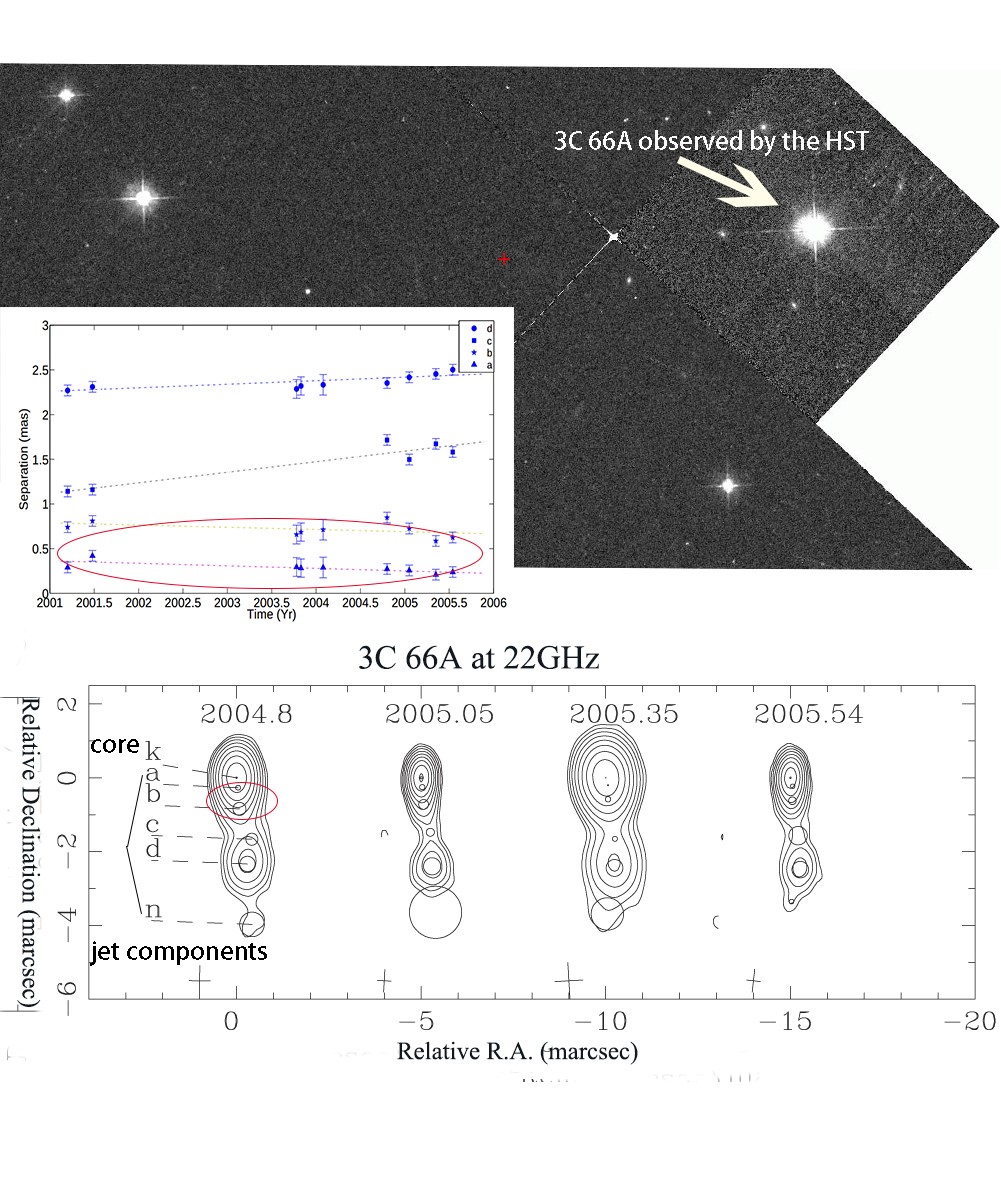An active galactic nucleus (AGN) is a compact region at the center of a galaxy that has a much higher than normal luminosity. A galaxy hosting an AGN is called an active galaxy. The radiation from AGN is believed to be a result of accretion of materials by a supermassive black hole (SMBH) at the center of its host galaxy. In the standard model of AGN, materials around the black hole will form an accretion disk. Accretion disk could produce fast and highly collimated plasma outflow, which is called relativistic jets. According to the standard model, when the jet motion is close to the line of sight, the emission will be dominated by the jet and this object will appear as a blazar. Blazars are among the most energetic phenomena in the universe.
Recently, researchers in our Observatory,Dr. Guangyao Zhao, Prof. Yongjun Chen and Prof. Zhiqiang Shen, have discovered long term (more than 10 years) apparent inward motion in the jet of a blazar, 3C 66A. This indicates the opacity in the vicinity of the SMBH has changed. This work is published in Astronomical Journal (Zhao et al., 2015, AJ, 149, 46).
Under the current highest resolution in astronomy (parsec-scale), which is achieved by very long baseline interferometry, the extended emission of the jet gets resolved and only the compact part in the vicinity of the SMBH can be observed. In this case, the morphology of a blazar is usually consisting of a bright, compact and flat spectrum core and several jet components. The core is located at where the opacity is unity, i.e. where the jet turns from optically thick into optically thin. The jet components are usually moving downstream the jet as time goes.
“Apparent inward motions are statistically rare, less than 2 percent according to previous statistical studies (MOJVE results). The most common explanation for such motions would be a newly emerged, fast moving component passing by the core region.” Prof. Yongjun Chen explained, “Since it is still very close to the core and could not be resolved under current resolution,the observed “core”, which is the combination of the core and this new component, has been moving downstream the jet, i.e. the inner components are apparently inward moving.” However, most of these previously reported inward motions are short-term motions and often associated with flares. What Zhao et al. found in 3C 66A is different; the components show inward motions for at least 10 years (2001-2011). This is quite rare and cannot be explained by the argument mentioned above, because no new components are detected during the 10 years. The authors argue it could be attributed to change of the opacity.
Blazar are often variable, and it is also natural if the physical conditions around the central engine such as the opacity changes. However, studying the opacity changes requires high-resolution, multi-epoch and multi-frequency, even phase-referencing observations. So these studies are rare. “This work provides a good target of studying opacity change which will be good for understanding the environment surrounding the SMBHs.” Prof. Zhiqiang Shen concluded.

Fig 1. 3C 66A is a typical blazar, with emission from radio to γ-rays. Previous multi-epoch VLBI observations have detected apparent superluminal motions, indicating there are high energy process going on in this source. Zhao et al. analyzed 4 epoch data of this source at 3 frequencies observed with the Very Long Baseline Array in 2004-2005 and studied the proper motion of jet components. Combined with previous results at each corresponding frequency, they found that the innermost 2 components (i.e. component a & b) showed apparent inward motions during 2001-2005. The MOJAVE team has monitored this source at another frequency during 2006-2011 and their results are consistent with this work, which means the innermost part of the jet has been apparently moving towards the core for at least 10 years.